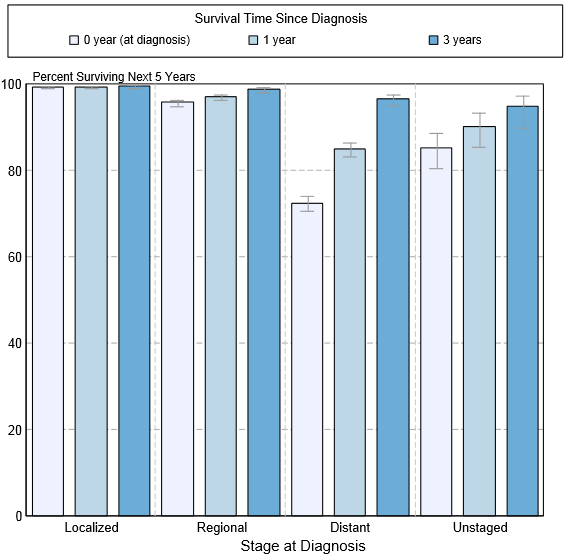Testicular cancer natural history, complications and prognosis
Editor-In-Chief: C. Michael Gibson, M.S., M.D. [1]
|
Testicular cancer Microchapters |
|
Diagnosis |
|---|
|
Treatment |
|
Case Studies |
|
Testicular cancer natural history, complications and prognosis On the Web |
|
American Roentgen Ray Society Images of Testicular cancer natural history, complications and prognosis |
|
FDA on Testicular cancer natural history, complications and prognosis |
|
CDC on Testicular cancer natural history, complications and prognosis |
|
Testicular cancer natural history, complications and prognosis in the news |
|
Blogs on Testicular cancer natural history, complications and prognosis |
|
Risk calculators and risk factors for Testicular cancer natural history, complications and prognosis |
Overview
The prognosis of testicular cancer is favorable since this type of cancer can be cured. Between 2004 and 2010, the 5-year relative survival of patients with testicular cancer was 96.6%.[1]
Complications
Testicular cancer may spread to other parts of the body. The most common sites include the:
- Abdomen
- Lungs
- Retroperitoneal area (the area near the kidneys)
- Spine
Complications of surgery can include:
- Bleeding and infection after surgery
- Infertility (if both testicles are removed)
Infertility can occur among patients with testicular cancer. If the patient is of childbearing age, he should be advised informed about the possibility of infertility and the solutions to this problem, such as sperm banking.
Men who had testicular cancer are at an elevated risk of cancer in the other testis.
Prognosis
5-Year Survival
- Between 2004 and 2010, the 5-year relative survival of patients with testicular cancer was 96.6%.[1]
- When stratified by age, the 5-year relative survival of patients with testicular cancer was 95.4% and 86.4% for patients <65 and ≥ 65 years of age respectively.[1]
- The survival of patients with testicular cancer varies with the stage of the disease. Shown below is a table depicting the 5-year relative survival by the stage of testicular cancer:[1]
| Stage | 5-year relative survival (%), (2004-2010) |
| All stages | 95.3% |
| Localized | 99.2% |
| Regional | 96% |
| Distant | 73.1% |
| Unstaged | 78.8% |
- Shown below is an image depicting the 5-year conditional relative survival (probability of surviving in the next 5-years given the cohort has already survived 0, 1, 3 years) between 1998 and 2010 of testicular cancer by stage at diagnosis according to SEER. These graphs are adapted from SEER: The Surveillance, Epidemiology, and End Results Program of the National Cancer Institute.[1]
Recurrence
Patients who are diagnosed with testicular cancer should be followed up to detect any recurrence of the cancer. Follow up visits should be scheduled with the physician at time intervals that vary according to the type and stage of testicular cancer. During follow up visits, patients should undergo laboratory tests to measure the level of tumor markers as well as imaging.
References
- ↑ 1.0 1.1 1.2 1.3 1.4 Howlader N, Noone AM, Krapcho M, Garshell J, Miller D, Altekruse SF, Kosary CL, Yu M, Ruhl J, Tatalovich Z,Mariotto A, Lewis DR, Chen HS, Feuer EJ, Cronin KA (eds). SEER Cancer Statistics Review, 1975-2011, National Cancer Institute. Bethesda, MD, http://seer.cancer.gov/csr/1975_2011/, based on November 2013 SEER data submission, posted to the SEER web site, April 2014.
